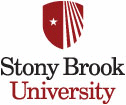MAT 211 Introduction to Linear Algebra
Stony Brook Fall 2013
About this course: (From the undergraduate bulletin) Introduction to the theory of linear algebra with some applications; vectors, vector spaces, bases and dimension, applications to geometry, linear transformations and rank, eigenvalues and eigenvectors, determinants and inner products. May not be taken for credit in addition to AMS 210.
This course is an introduction to the theory which has
developed around the solution of systems of linear equations. Linear
algebra plays a key role in mathematics and has an enormous amount of
applications (see for instance this website).
Most likely, in your daily life, you use technology that uses linear
algebra.
As in any math course, do not be discouraged if you find
yourself struggling with a problem or a concept for hours. You will
need to do computations in order to understanding the material, but do
not waste time in mindlessly memorizing techniques.
Prerequisite: C or higher in AMS 151 or MAT 131 or 141
or coregistration in MAT 126 or level 7 on the mathematics placement
examination
Instructor: Moira Chas
Office Hours: : Mo 1:30-3:30pm in 3-119 Math Tower,
Wednesday 2:45pm-3:45pm in P-143 Math Tower.
Email: moira.chas at stonybrook.edu
Office Hours: : Wednesday 1:30pm-2:30pm in Math Tower S-240C, Thu 4:00pm-6:00pm in MLC
Email: xuemiao.chen at stonybrook.edu
Grader: Ivan Chio
Office Hours: : Monday 1-2pm MLC
Email: xuemiao.chen at stonybrook.edu
When: The course meets Mo-We-Fr 12pm-12:53pm.
Where: Simons Center 103.
 |
Text:
Linear Algebra with Applications, 5/E, by Otto Bretscher, ©2013 •
Pearson • Cloth, 528 pp Published 12/10/2012 • This book is available at the campus bookstore. The 4th edition of the book can also be used. If there is any problem with the number of the homework assignement, I will post both versions. You can also rent an electronic-only versions of the text available at CourseSmart (Price to Student $67.99). |
Homework |
Homework will be assigned weekly and is due Mondays before class. Homework is mandatory because it is an esential part of the course: It is not possible to learn mathematics without working on problems
|
Problem assignments can always be found here. |
Every homework assignment must be handed
in with a header containing:
|
|
|
Examinations and grading: There will be two midterm exams (in class), and a cumulative final exam. The dates are listed below. Success on the exams will require correct and efficient solutions to the more difficult of the homework problems. Part of your grade will be based on class participation in the lecture (note that asking questions in class counts as class participation).
| Exam | Date |
% of Final Grade | |
| Midterm 1 |
Monday 9/30 |
12-12:53pm | 20% |
| Midterm 2 |
Monday 11/4 | 12-12:53pm |
20% |
| Final Exam | Thursday 12/12 | 5:30pm-8pm | 40% |
| Homework, participation, etc. | 20% | ||
Make sure that you can attend the exams at the scheduled times; make-ups will not be given. If one midterm exam is missed because of a serious (documented) illness or emergency, the semester grade will be determined based on the balance of the work in the course.
Grades will be posted in Blackboard.All exams are closed notes and closed book. It is not permitted to use cell phones, calculators, laptops, MP3 players, Blackberries or other such electronic devices at any time during exams. Once the exam has begun, use of such devices or having such devices in view, as well as having notes or books on the desk or in view will be considered cheating and will be referred to the Academic Judiciary. Similarly, once the exam has begun any communication with a person other than the instructor or proctor will be considered cheating and will be referred to the Academic Judiciary.
Reading: The textbook is intended to be read. Read the assigned sections before the lecture! This will greatly increase your comprehension, and enable you to ask good questions in class. Furthermore, the lectures will not always be able to cover all of the material for which you will be responsible.
Disabilities: If you have a physical, psychological, medical, or learning disability that may impact your course work, please contact Disability Support Services at http://studentaffairs.stonybrook.edu/dss/ or (631) 632-6748. They will determine with you what accommodations are necessary and appropriate. All information and documentation is confidential.
Students who require assistance during emergency evacuation
are encouraged to discuss their needs with their professors and
Disability Support Services. For procedures and information go to the
following website:
Academic Integrity: Each student must pursue his or her
academic goals honestly and be personally accountable for all submitted
work. Representing another person's work as your own is always
wrong. Faculty are required to report any suspected instances of
academic dishonesty to the Academic Judiciary. For more comprehensive
information on academic integrity, including categories of academic
dishonesty, please refer to the academic judiciary website at
